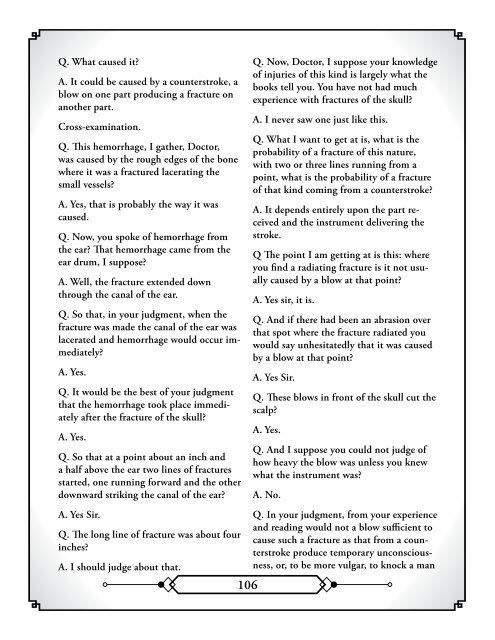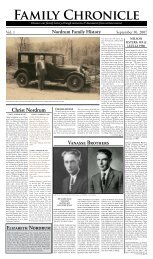Book 2 - Nathan, Amy, Madison and Ethan Berga
Book 2 - Nathan, Amy, Madison and Ethan Berga
Book 2 - Nathan, Amy, Madison and Ethan Berga
You also want an ePaper? Increase the reach of your titles
YUMPU automatically turns print PDFs into web optimized ePapers that Google loves.
Q. What caused it<br />
A. It could be caused by a counterstroke, a<br />
blow on one part producing a fracture on<br />
another part.<br />
Cross-examination.<br />
Q. This hemorrhage, I gather, Doctor,<br />
was caused by the rough edges of the bone<br />
where it was a fractured lacerating the<br />
small vessels<br />
A. Yes, that is probably the way it was<br />
caused.<br />
Q. Now, you spoke of hemorrhage from<br />
the ear That hemorrhage came from the<br />
ear drum, I suppose<br />
A. Well, the fracture extended down<br />
through the canal of the ear.<br />
Q. So that, in your judgment, when the<br />
fracture was made the canal of the ear was<br />
lacerated <strong>and</strong> hemorrhage would occur immediately<br />
A. Yes.<br />
Q. It would be the best of your judgment<br />
that the hemorrhage took place immediately<br />
after the fracture of the skull<br />
A. Yes.<br />
Q. So that at a point about an inch <strong>and</strong><br />
a half above the ear two lines of fractures<br />
started, one running forward <strong>and</strong> the other<br />
downward striking the canal of the ear<br />
Q. Now, Doctor, I suppose your knowledge<br />
of injuries of this kind is largely what the<br />
books tell you. You have not had much<br />
experience with fractures of the skull<br />
A. I never saw one just like this.<br />
Q. What I want to get at is, what is the<br />
probability of a fracture of this nature,<br />
with two or three lines running from a<br />
point, what is the probability of a fracture<br />
of that kind coming from a counterstroke<br />
A. It depends entirely upon the part received<br />
<strong>and</strong> the instrument delivering the<br />
stroke.<br />
Q The point I am getting at is this: where<br />
you find a radiating fracture is it not usually<br />
caused by a blow at that point<br />
A. Yes sir, it is.<br />
Q. And if there had been an abrasion over<br />
that spot where the fracture radiated you<br />
would say unhesitatedly that it was caused<br />
by a blow at that point<br />
A. Yes Sir.<br />
Q. These blows in front of the skull cut the<br />
scalp<br />
A. Yes.<br />
Q. And I suppose you could not judge of<br />
how heavy the blow was unless you knew<br />
what the instrument was<br />
A. No.<br />
A. Yes Sir.<br />
Q. The long line of fracture was about four<br />
inches<br />
A. I should judge about that.<br />
106<br />
Q. In your judgment, from your experience<br />
<strong>and</strong> reading would not a blow sufficient to<br />
cause such a fracture as that from a counterstroke<br />
produce temporary unconsciousness,<br />
or, to be more vulgar, to knock a man









